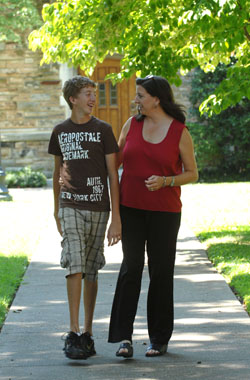
Vanderbilt is studying a new therapy to prevent enlargement of the aorta in patients with Marfan syndrome, like Sam Davis, above, with his mother, Cheryl. (photo by Neil Brake)
New therapy may ease cardiac ills of Marfan syndrome

Larry Markham, M.D.
Researchers at the Monroe Carell Jr. Children's Hospital at Vanderbilt are studying a new option to address a serious side effect for children with Marfan syndrome — an enlarged and weakened aorta.
The National Institutes of Health (NIH), through the Pediatric Heart Network (PHN), has added Children's Hospital to a multi-center trial to test whether the angiotensin receptor blocker Losartan can successfully control the most dangerous forms of the condition in children. A second arm of the trial will test the current standard therapy, the beta-blocker Atenolol.
Marfan syndrome is an inherited disorder caused by a mutation in the gene that controls certain connective tissues and is characterized by elongated bones and ligaments. The eyes and lungs can also be affected and the disease can cause a dangerous weakness in the wall of the aorta — the large vessel that carries blood from the heart to the rest of the body. If the aorta enlarges to a critical point, surgery is needed to prevent a fatal burst.
The PHN is a collection of institutions working to increase clinical trials in pediatric cardiovascular medicine.
“Vanderbilt was added as an ancillary trial site in large part due to our recent Medical Center grant for translational medicine, also our history with clinical trials, and strong cardiovascular division," said Larry Markham, M.D., assistant professor of Pediatric Cardiology.
Previous research by Hal Dietz, M.D., of Johns Hopkins, showed that Losartan, by inhibiting growth factors seen in Marfan syndrome, can be of benefit.
“His preliminary human data suggests benefit in children,” Markham said. “However, a randomized trial is necessary for a definitive answer as to which therapy is most effective."
Over the years, doctors noticed and carefully documented the benefits of beta blockers that some Marfan patients took for other reasons. Cheryl Davis was one of those patients.
"I had been monitored for Marfan's for years, but when I was a junior in college I had debilitating headaches," Davis recalled. "I was put on a beta blocker for my migraines and then they noticed the root of my aorta had actually shrunk."
Davis began taking large doses of beta blockers to control the dangerous stretching of her vessels. Meanwhile, researchers developed a mouse model and defined the molecular pathways leading to the abnormal growth. The animal model showed benefit when treated with the angiotensin receptor blocker Losartan.
What is not known is whether children with Marfan syndrome might benefit more from the current therapy of beta blocker — ramped up to the highest possible beneficial level — or from Losartan, a therapy based on different pathway.
When Davis gave birth to her son, Sam, she knew Marfan syndrome would have a different meaning in her life.
"When he was born I looked at Sam's long fingers and told my husband he had Marfan's too. Living with Marfan’s — for me personally — was not a big deal, but as a parent, watching your child, it is very different. I know women who have lost children from dissected aortas. Sam is growing at this mind-numbing pace, and it's tough not to be constantly caught up in the worry," Davis said.
Sam, now 12, cannot play basketball or football or any sports that would over-exert him or cause a blow to the chest. Instead, the strapping, 6-foot adolescent plays golf and summer baseball. Still, he is considered to have a more moderate version of Marfan's.
"We had him checked thoroughly and while he is already on a beta blocker, his arorta size is within normal limits, so far," Cheryl said. "But he would have willingly participated. We are thrilled the trial has come here to Vanderbilt, but I'm also happy he's not eligible right now."
Markham said even if patients like Sam aren't in line to reap direct benefit from the current study, the work will be important for generations to come.
"This study is exciting because there have been limited drug studies for children with heart disease. It's only now, through pooling of resources with the NIH through the PHN, the two drug companies, and the Marfan Foundation that we are able to pursue this important study for Marfan syndrome and to establish a culture of clinical trials for pediatric heart disease."













